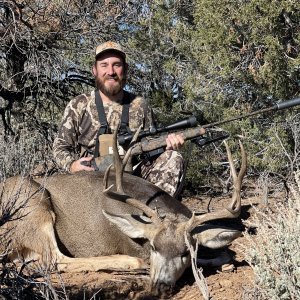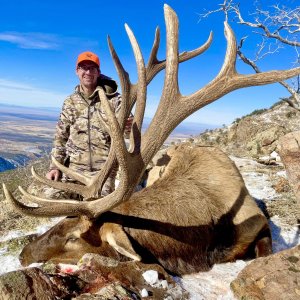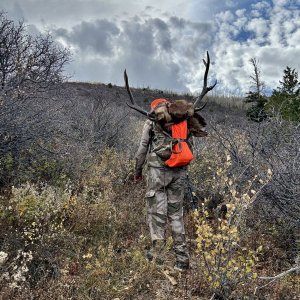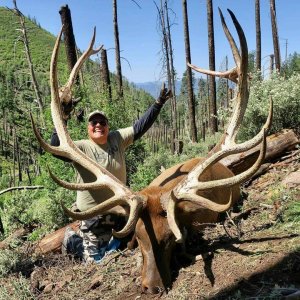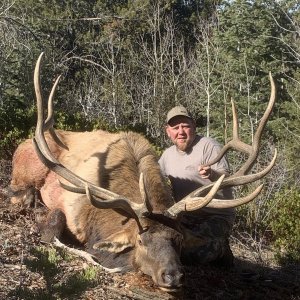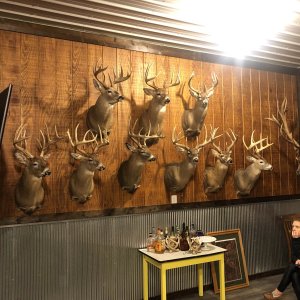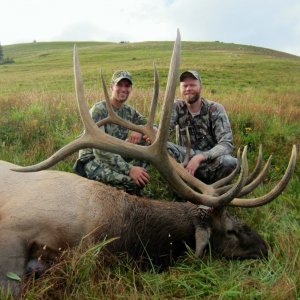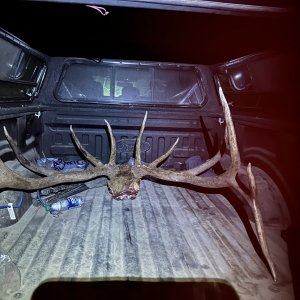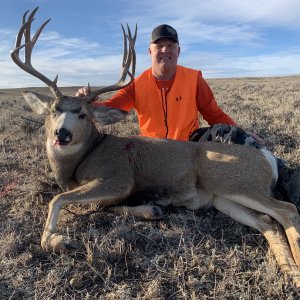Do activated-carbon garments really work?
I have been a bow hunter for more than twenty years; during this time I have watched the commercialized hunting arena develop.
The extreme commercialization of bow hunting has, in my opinion, resulted instances where hunters have been duped. In fact, I can think of several products that are down right gimmicks and obviously seek to play upon consumer ignorance and slob hunters looking for success shortcuts.
The question has been raised: Can activated-carbon scent elimination clothing really give you an edge against the nose of this animal?
I was once asked, ?What do you think is the biggest gimmick on the (outdoors equipment) market is today?? I will warn you up front that my response to the question, which follows, may be a bit painful. Furthermore, I will say that if you do find my response painful, it's likely that you spent your hard earned wages on the product that I'm about to scrutinize.
Here goes: I believe the biggest gimmick on the outdoors equipment market today is activated-carbon scent elimination clothing that are being marketed under various brand names. You know the ones I'm talking about, so I won't name names. I'm talking about all of them.
If you're a bow hunter and believe in the effectiveness of these special garments, hopefully you aren't so angry that you stop reading this article. Because if you read this in its entirety, I promise that you will learn something.
There is a difference between ignorance and stupidity, and I would never dream of calling my fellow bow hunters stupid. It's the ignorance (i.e. the lack of knowledge) factor that has led many quality and even professional bow hunters to be fooled by the claims made by the manufacturers of scent elimination clothing.
I plan to educate you, not point fingers or spit propaganda. Before I do though, I'll tell you a bit about myself. I am a biologist by education and received my Bachelor of Science degree from Florida State University. I've worked in the environmental protection field for more than ten years.
I have worked with various forms of activated-carbon, the same material that is used in the many brands of scent elimination clothing. Many of you have read articles by authors that claim their scent elimination clothing was pinnacle in helping them tag the biggest buck; without it, the hunt would not have been successful.
What's new? That is a common marketing strategy used to push new equipment. Bow hunters, despite what gear they choose, are a traditional bunch. Many of us have gained knowledge on how to hunt our query and what equipment to use through word of mouth and testimonials of other perceived more knowledgeable bow hunters.
When Chuck Adam, for instance, talks or writes, I listen and pay attention. I'd be crazy if I didn't. He is without question a knowledgeable bow hunter and we all stand to learn a lot from an experienced bow hunter like him.
The problem with these scent elimination garments is, unless you have a science background and to an even greater extent, have worked in the environmental protection / remediation profession, you simply cannot posses a clear understanding of how activated-carbon works.
Structure of coconut husk activated-carbon seen through an electronic microscope.
So, as I promised, I am going to tell you how activated-carbon works and why it is my opinion that activated-carbon scent elimination garments are ineffective. Then you can take the information presented here and make an educated decision for yourself.
activated-carbon comes in several forms and is used in many applications as a filtering or cleansing media. activated-carbon can be manufactured from carbonaceous material, including coal (bituminous, subbituminous, and lignite), peat, wood, or nutshells (i.e., coconut shells or walnut shells).
The manufacturing process consists of two phases: carbonization and activation. The carbonization process includes drying and then heating to separate by-products, including tars and other hydrocarbons, from the raw material, as well as to drive off any gases generated. Heating the material at 400?600?C (752-1472?F) in an oxygen-deficient atmosphere that cannot support combustion completes the carbonization process.
activated-carbon comes in the form of a very fine powder, which is impregnated or weaved into the textile fibers of garments. It also comes in a granular form. Both forms are used in various applications including to purify both water and air. Some of the popular drinking water filters and mechanical air filters on the market use activated-carbon as a filter media.
activated-carbon is an extremely porous material with high ratios of surface area to unit weight. One pound of activated-carbon contains up to 100 acres of surface area!
activated-carbon has a particular affinity to organic materials such as volatile organic compounds or VOC?s. Human odor is composed of different gaseous molecules of VOC?s and other chemicals such as hydrogen sulfides, which are absorbed by activated-carbon.
Think of activated-carbon as a common sponge that you would use to wash dishes with. Take a sponge and place it in a cup of water. What happens? It soaks up the water. The sponge, like activated-carbon, has thousands of little pores and channels running through it. When activated-carbon soaks up human ?stink? odors, it does so through a process called adsorption.
Stinky gasses (i.e. human odors) are adsorbed into the many micro pores on and within the activated-carbon and are retained there. Now, what happens when a sponge becomes saturated?
A sponge that is saturated with water cannot adsorb any more. Hold a saturated sponge full of water in your hand and you will observe water dripping from it. When activated-carbon in a water or air filter becomes saturated it is called breakthrough.
Forms of activated-carbon
www.chemvironcarbon.com
In short, when a water?s or air filter?s filter media (i.e. activated-carbon) becomes saturated with contaminants, the filter is rendered useless and the contaminants contained in the water or air stream pass through the filter. After a while, you will be drinking dirty water or breathing stinky air until the filter is replaced. Makes sense right?
Think of activated-carbon as a molecular sponge. As is the case with any sponge, activated-carbon can only hold or adsorb so much stinky stuff. Once activated-carbon becomes saturated with contaminants, it must be reactivated or replaced entirely.
What do you do with a sponge that is saturated with water? You squeeze it to release the adsorbed water so you can reuse it. Or, you simply get a new dry sponge. Like the sponge analogy, activated-carbon must be ?squeezed out? so to speak, in order to reactivate it for reuse.
Now you know how activated-carbon works. Most of the information I just provided can be found on some of the more popular scent elimination garment manufacturers? web sites.
So far you might be thinking to yourself ?Wow, activated-carbon really works?. Well, it does work, sort of.
activated-carbon is a fine filter media, but using activated-carbon as the key component in a scent elimination garment is not a practical application.
Unlike a common kitchen sponge, you can't just leave it on the counter and let it dry out. In order to re-activate activated-carbon, it must undergo a process called Pyrolysis. To fully re-activate saturated activated-carbon, you must heat it to approximately 800 ?C or 1,472 ?F, in a controlled atmosphere of low oxygen concentration to reduce the possibility of combustion.
This is scientific fact and is even stated in the U.S. Army Corps of Engineers ? Engineering and Design, Adsorption Design Guide, Design Guide No. DG1110-1-2, if you'd like to check it out for yourself. This fact is not however mentioned on any of the popular scent elimination clothing manufacturers? websites.
One of the most popular scent elimination clothing manufactures instructs consumers to simply place worn garments in a common household clothes dryer for 20 to 30 minutes to re-active the carbon in the garment. The average temperature generated by a clothes dryer does not even come close to being able to generate the extreme temperatures necessary to drive out contaminants absorbed in the many micropores and channels of activated-carbon. In fact, most residential clothes dryers only heat up to a temperature that is well under 200?F.
Those of you, whom use water filters or air filters in your homes, think about it. Why can't you just boil your filters in hot water or throw them in the oven or microwave for a few minutes to re-activate the carbon filter media. You can't; that's why. You don't own special multi million-dollar pyrolysis thermal regeneration equipment that produces enough heat to re-activate carbon. Therefore, you have to buy new filters every now and then.
Re-activating carbon for industrial uses is big business. Type in the words ?activated-carbon? in your favorite Internet search engine and you will see what I'm talking about here. In order to fully reactivate the activated-carbon in one of the many scent elimination garments on the market, you might as well just throw the garment in your campfire, because the extreme heat necessary to re-activate the carbon would likely destroy the garment anyway.
Forgive my sarcasm, but I tend to get irritated when I see good folks getting duped. And as a class, I think bow hunters are a pretty good bunch. So as a product, I think all the activated-carbon scent elimination clothing products on the market are nothing more than gimmicks.
I do not believe, based on sound science, these garments are even effective the first time you use it. Think about it. Each garment would have to be manufactured and placed in a sealed, scent proof bag when shipped and remain sealed on the shelf at retail stores. This is not the case, however.
From the minute the clothing is manufactured, it begins to adsorb ?stink? and continues to adsorb ?stink? while awaiting an ignorant, misinformed consumer to purchase it. It is likely that the activated-carbon contained in the garment is already completely saturated with ?stink? upon being purchased.
Many of the scent proof garment manufacturers somewhat acknowledge this, in an attempt to bring some legitimacy to their product. They recommend that you immediately wash and re-activate garments by placing them in a clothes dryer as soon as the product is purchased. Funny, they also happen to recommend their own brand of laundry detergent that is special made for these special garments.
As I explained above, washing and drying the garment is merely an exercise in futility. At best, the only way these garments could be manufactured and utilized effectively would be if they were designed for one time use. In other words, they would have to be disposable.
The military actually uses activated-carbon suits as a kind of chemical protection garment, but they're a single-use, disposable garment and not intended for multiple washings.
Here is something else you should consider before purchasing one of these products: activated-carbon?s adsorption effectiveness when used in an air filter application becomes greatly reduced when it is wet. So what happens when you sweat during those humid early season bow hunts? That's right, your clothing gets wet and becomes even less effective.
A leading manufacturer of activated-carbon garments admits that no laboratory testing has been conducted to determine the effectiveness of the clothing when it is wet from hunter?s perspiration.
So why the craze? Why are so many hunters rushing out to purchase these garments, when the science-based fact is that they don't work?
As I mentioned earlier, consumer ignorance is one reason. I think another reason is that many hunters so badly want to believe that they can purchase something that will render them invisible to a whitetail?s or elk?s nose.
As I said earlier, many of you have read articles by authors that claim their scent elimination clothing was pinnacle in helping them tag the biggest buck; with out it, the hunt would not have been successful. I truly believe the fact that these hunters who wore these garments while achieving success, can be chalked up to being merely a coincidence. Many of the authors who wrote these type articles failed to mention they were wearing their lucky hat and that their lucky rabbits foot was in their pocket at the time.
All sarcasm aside, I think many successful hunters who wear these special garments fail to recognize that they have been consciously paying closer attention to personal hygiene techniques before every hunt.
You must understand that none of the success story articles that push these special garments are based on science studies. They are opinions; misinformed ones at that.
I've talked to a few technical representatives with some of the more popular scent elimination clothing manufacturers and none of them have performed controlled scientific studies to demonstrate the true effectiveness of these garments. However, they claim to have ?field tested? the garments. Come on folks. How do you field-test these garments?
It is said that a deer can smell nearly 1,000 times better than humans. You cannot legitimately observe the effectiveness of these garments or read a whitetail?s mind. No one, to the best of my knowledge, has contracted a non-biased independent laboratory or university to demonstrate the effectiveness or ineffectiveness of this clothing.
It is my belief that the manufacturers of these specialty garments know what the results of such a study would show; therefore it would not behoove them to undertake such an exercise. So they just claim the garments are field tested by the product-pushing pros.
As stated earlier: This is just my opinion, but it's one based on sound science, education and a realistic view of product marketing techniques.

